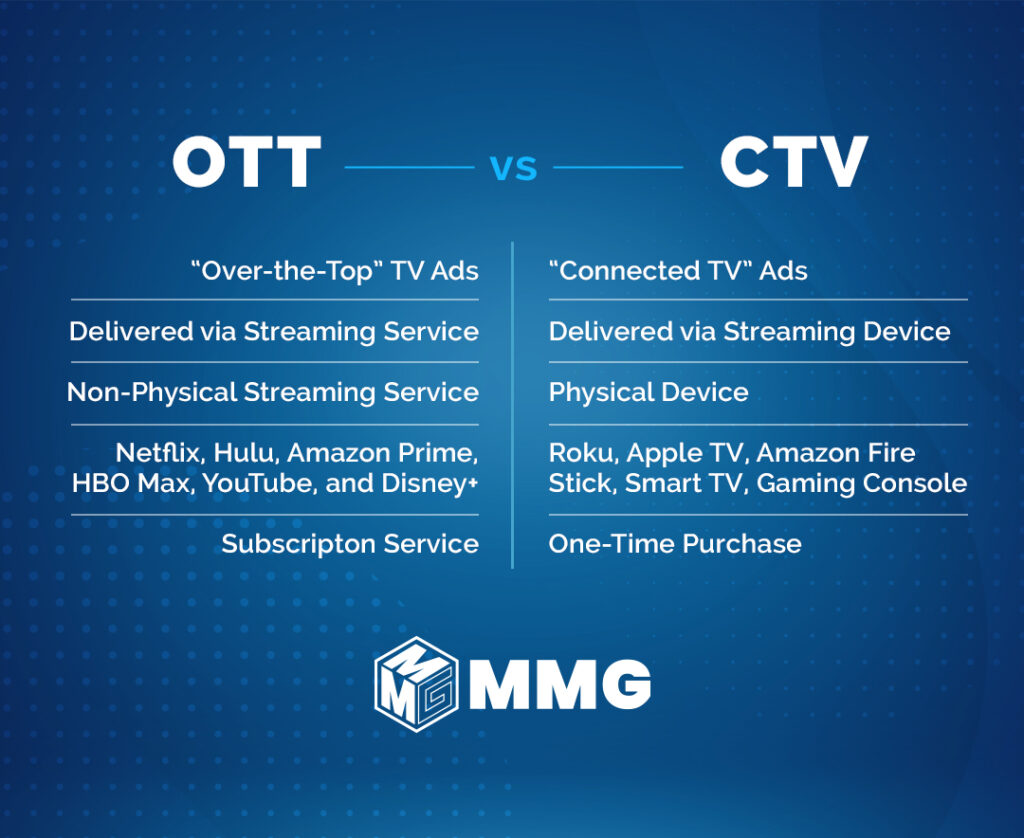The difference between OTT vs CTV advertising can seem confusing at first. But if you want your business to enter the digital TV advertising game, then you’ll need to understand the lingo. OTT and CTV are two terms that’ll likely come up when discussing your marketing mix. What do these two terms mean? What is the difference? How can they help you maximize your ad performance? We’ll answer that here.
OTT & CTV
What is OTT? What Does OTT Stand For?
OTT stands for “over-the-top”. It describes the process of streaming video, audio, or messaging content over-the-top of the internet, instead of more traditional distribution, such as cable. Some popular OTT platforms include Netflix, Hulu, Amazon Prime, HBOMax, YouTube, and Disney+.
OTT advertising refers to video ads delivered through a streaming video subscription service.
What is CTV? What Does CTV Stand For?
CTV stands for “connected TV”. It refers to any device connected to the internet via Smart TV technology, streaming devices like Roku and AppleTV, or gaming consoles.
CTV advertising refers to video ads delivered through a streaming device, such as Roku Box/TV, Amazon Fire Stick/TV, or AppleTV.
The Difference Between CTV & OTT Advertising
So, what is the difference between CTV and OTT advertising? Well, first let’s review what’s the same. They both offer video spot delivery over the internet to users based on their demographic profiles or content selection. These may include location, age, gender, income, or education, as well as their own viewing history. Likewise, advertisers typically deliver both CTV and OTT advertising as instream video ads, pre-roll, mid-roll, or post-roll. But that’s where the similarities end.
The differences between CTV and OTT depend largely on whether the streaming service or the streaming device delivers the ad. The streaming service provider delivers OTT ads, while the physical device delivers CTV ads.
Let’s take the example of a fictional persona, John Smith, who is watching an NFL game on Hulu via his Amazon Fire Stick. During the commercials, although the game is being broadcast nationwide, John sees a 15 second spot for a local Kia dealer 10 miles from his home. The ad features a model incentive, a unique selling proposition, and the dealer’s location, all tied together with a catchy jingle. The dealer is able to show this ad specifically to John (and NOT nationwide) because they either made their media buy with Hulu or Amazon. Technically speaking, the ad John saw could be either CTV or OTT, depending on where the media buy was placed. If the spot was delivered via Hulu, it would be an OTT ad. If, however, the spot was delivered via his Fire Stick, then it would be CTV.
OTT vs CTV Ads

Benefits of OTT and CTV Advertising
In 2022, research studies suggested the following stats:
- 87% of US households had at least one CTV device1
- 88% of US households had at least one OTT video service, with the average US consumer subscribing to at least four services2
Based on these numbers, it’s clear that advertising via OTT and CTV has the potential to get your brand in front of eyes. Likewise, the percentage of households with CTV devices and OTT video service subscriptions are likely to increase with time.
In addition to the potential reach, there are many benefits to making OTT and CTV advertising part of your advertising strategy. These include:
- Hyper-Targeted Demographic Reach
- One of the key advantages of OTT and CTV advertising is its ability to deliver highly targeted messages to specific audience segments. Advertisers are able to pinpoint their audience based on demographics, interests, behavior, and more. Precise targeting ensures that the most relevant viewers see your ads. This increases the likelihood of driving meaningful engagement and conversions.
- With advanced AdTech that provides valuable first-part data, you can target your advertising even more.
- Measurable Results & KPIs
- When advertising over CTV devices, advertisers gain access to comprehensive analytics, which provide insights into key performance metrics such as impressions, views, engagement, and conversions. Taking a data-driven approach allows you to track the effectiveness of your campaigns and make informed decisions to optimize performance and maximize ROI.
- Omni-Channel Marketing
- Whether it’s a smart TV, computer, tablet, or mobile phone, OTT advertising can deliver personalized messages to consumers across multiple devices, while targeting them at the household level. This omnichannel approach helps brands lead customers through the buyer’s journey and get them to the bottom of the sales funnel faster.
OTT & CTV Advertising Services
While OTT & CTV advertising can help your ads reach the right people, expert implementation is key to getting the maximum benefits. Team MMG’s marketing team are experts in digital TV advertising. We can provide the guidance you need to optimize your digital TV marketing strategy. Contact us today!
Contact Us


